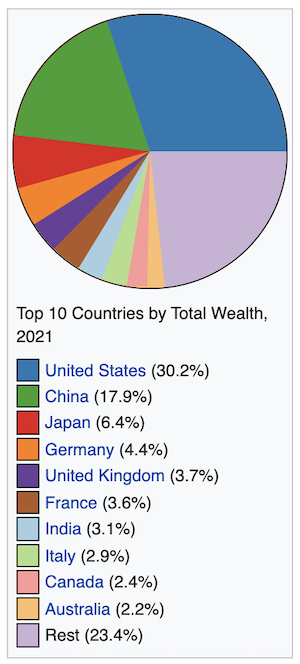
Top Ten Countries by Total Wealth

IssueM Articles

Bryan Pinsky has been named President, Individual Retirement and Tim Heslin has been named President, US Life Insurance, of AIG Life & Retirement, a division that American International Group, Inc., has said it plans to eventually spin off through an initial public offering.
Pinsky and Heslin assumed their new roles this week, both continuing to report directly to Todd Solash, CEO, Individual Retirement and Life Insurance, AIG Life & Retirement. Pinsky is based in Woodland Hills, California, where AIG’s Individual Retirement business is headquartered.
Pinsky joined AIG in 2014 and most recently was senior vice president of Individual Retirement Pricing and Product Development. He joined AIG from Prudential where he led the annuity product team and, before that, held various life and annuity product development positions with Allstate. He is a Chartered Financial Analyst and Fellow of the Society of Actuaries.
Heslin joined AIG in 1999 and most recently was Chief Life Product, Pricing and Underwriting Officer for AIG Life US. Previously, he headed Risk Selection for AIG’s Global Life Businesses, including Life, Health and Disability for Europe, the Middle East and Africa. He is a Fellow of the Society of Actuaries and a Member of the American Academy of Actuaries. He works out of Houston, where the US Life Insurance business is headquartered, and Nashville, Tennessee.
Allianz Life Insurance Company of North America and Morningstar Investment Management LLC are partnering to “help individuals allocate their retirement savings to its annuity products through the Morningstar Retirement Manager service,” Allianz Life announced this week.
The Allianz Lifetime Income+ Annuity with the Lifetime Income Benefit will be the first Allianz Life product to be added as Allianz Life enters the defined contribution market.
“Through Morningstar Retirement Manager, individuals receive recommendations to help ensure that they are allocating the right amount of their investable assets to guaranteed income at the right time for what could likely be a lengthy retirement,” the release said.
Allianz Lifetime Income+ is a fixed index annuity (FIAs) with a guaranteed lifetime withdrawal benefit (GLWB). FIAs provide account growth potential through the purchase of options on an equity index. A July 22 RIJ article described the product.
GLWBs offer a combination of liquidity and protection from longevity risk—the risk of running out of income from savings. Lifetime Income+ also offers the potential for the monthly income benefit to grow annually and keep up with inflation.
Morningstar Retirement Manager is a managed accounts and advice service for retirement plan participants. Its algorithms can help participants decide how much to save, how to invest, and when to take Social Security.
Only individuals whose retirement plans offers both Morningstar Retirement Manager and the Allianz Life annuity will have access to this service offering.
The aggregate funded percentage of all multiemployer plans (MEPs) in the US reached 92% on June 30, 2021, up from 88% at the end of 2020, according to the 2021 mid-year results of Milliman’s Multiemployer Pension Funding Study (MPFS), released this week.
That’s the highest aggregate funding level recorded for MEPs since December 31, 2007, before the Great Recession, the global actuarial consulting firm reported. These MEPs, often union-sponsored, are pensions, and shouldn’t be confused with “multiple employer plans,” which are 401(k) defined contribution plans.
“Strong investment returns in the first half of 2021, estimated at 6.9% for our simplified portfolio, helped improve pension funding,” a Milliman release said.
Some plans continue to struggle, however. “This is consistent with prior periods and reflects lower funding percentages coupled with negative cash flow for these plans,” MIlliman said.
The MPFS results don’t incorporate the impact of the American Rescue Plan (ARP), effective last March, or the impact of the COVID-19 pandemic on multiemployer pensions (MEPs) plans and their membership, the full scope of which remains unknown at this time.
“The American Rescue Plan established a special financial assistance program for the most financially distressed multiemployer plans, which will improve their funding in the near-term,” said Nina Lantz, a principal at Milliman and co-author of the study. “But it remains to be seen whether this assistance can sustain these plans in the long-term,” she added. “Furthermore, the effects of the COVID-19 pandemic are still emerging, and future contribution levels for most plans will depend on the resiliency of various industries to restore and/or maintain their employment levels.”
To view the complete study, go to www.milliman.com/mpfs.
© 2021 RIJ Publishing LLC. All rights reserved.
The prolonged low interest rate environment has allowed publicly traded life/annuity (L/A) insurers to replace higher-cost debt with often much less expensive alternatives and thereby strengthen their balance sheets, according to a new AM Best special report.
Aggregate unadjusted total debt-to-capital ratio for the 16 publicly traded L/A insurers followed for the report has declined since 2011, to 24.1% at year-end 2020, according to the Best’s Special Report, titled, “Publicly Traded L/A Insurers Reduced Leverage, Improved Liquidity in 2020.”
Given the current interest rate environment and some uncertain views of the US economy, many of the larger companies continue to de-leverage (the primary reason for the decline in debt).
Total debt outstanding decreased by approximately $8 billion (or 8.1%) to $91.4 billion at year-end 2020. Prudential Financial reduced its total debt obligations by $6.3 billion in 2020, the largest dollar decrease of all the companies.
In 2020, the financial leverage of a significant portion of the publicly traded companies declined to its lowest unadjusted level of the last 10 years. The overall decline in debt-to-capital ratios can be attributed to the industry’s record-high capitalization, which enhances the ability to use earnings for debt servicing as well as regular dividend payments.
Amid the COVID-19 pandemic, many insurers turned to the Federal Home Loan Bank (FHLB) to tap into funds to bolster liquidity to prepare for a worst-case scenario, the report said. Aggregate borrowing for the L/A insurers grew year over year by approximately 18% in 2020, to $97.3 billion. Aggregate borrowing has increased steadily since 2014, but it has been outpaced by collateral pledged. As a result, the borrow-to-collateral percentage declined over the period.
Management’s track record of share repurchases and shareholder dividends is also considered in AM Best’s evaluation of operating leverage and expected coverage ratios. Given the uncertainty caused by COVID-19 in 2020, many companies paused their share repurchase programs and cut back on dividends to prepare financially for the worst. For the publicly traded companies, the aggregate capital returned to shareholders declined by 41% to $11.7 billion.
© 2021 RIJ Publishing LLC.
Jackson National Life, the largest issuer of variable annuities (VAs) in the US, has issued a new no-commission VA contract for clients of independent registered investment advisors (IRIAs) who want tax-deferred growth potential and protection against running out of money in retirement.
The new contract, called the Jackson Retirement Investment Annuity (JRIA), has these features:
In the past, VAs with guaranteed minimum withdrawal benefit riders typically allowed contract owners to turn on income whenever they want (between ages 55 and 85, for instance). The owners know that the longer they delay income the higher their withdrawal amount will be (as a percentage of their “benefit base,” which can’t be below their initial account value, regardless of market volatility, and may be augmented by “deferral bonuses” that reward waiting).
In this contract, Jackson appears to offer contract owners one age for starting income (65) and one annual guaranteed withdrawal rate (4.0% per year)—which coincidentally is no greater than the withdrawal rate that advisers consider to be “safe” (i.e., not hitting zero before the retiree’s death) over a 30-year retirement. There are no bonuses to entice contract owners to delay the income start date.
By structuring the contract this way, Jackson reduces or eliminates the expense associated with uncertainty over how the clients will use their income benefit. When clients have the flexibility to turn on income at will, they could all decide to do so in a prolonged market crash, when their account values are depressed. That could create large losses for the carrier.
© 2021 RIJ Publishing LLC. All rights reserved.

Outsourced insurance distributor (OID) is an expression (and an acronym) that I never heard before last Monday, though I’ve written several articles about them.
These are online annuity distribution platforms like RetireOne and DPL Financial Partners. Registered Investment Advisors (and their Investment Advisor Representatives, or IARs) without insurance licenses can use OIDs to learn about the no-commission annuities that life/annuity companies have created for the RIA market. Licensed OID agents can broker the sale of an annuity to the IAR’s client.
Now, thanks to a case in California, questions have arisen: Who should bear responsibility for the suitability of an annuity sale on an OID? Should it be the platform’s agents, the insurance carrier who issued the annuity, or the RIA adviser who recommended the annuity to his client? This issue was the subject of a spirited discussion on LinkedIn this week.
Three weeks ago, on July 29, the Insurance Commissioner of California announced the settlement of a complaint against Jefferson National Life Insurance, the direct provider of low-cost, investment-only variable annuities to RIAs. Nationwide bought Jefferson National in 2017.
An IAR, on behalf of an 86-year-old client, had exchanged (using the customary “1035 exchange” process) three existing variable annuities, involving some $636,000, for Jefferson National Life Monument variable annuities between 2015 and 2017.
Some of the exchanged annuities were evidently still within the so-called surrender period (the initial post-sale years during which a carrier typically recaptures the commission it paid to the agent or broker in the original sale). So the elderly client had to pay about $16,682 in surrender charges.
The client’s bank, noticing large checks to Jefferson National, alerted the client in 2017. The client complained to the California Insurance Commission. She said she didn’t understand what had been going on.
That led to an investigation and to the recent settlement. Without acknowledging guilt or innocence, Jefferson National agreed to refund $14,342 in surrender fees to the client and to pay California a fine of $150,000. The settlement was signed by Craig A. Hawley, Nationwide’s head of annuity distribution and the president of Jefferson National.
The regulator said that Jefferson National’s “sales process did not include an adequate independent review of the recommendations of [its] annuities by the non-insurance licensed investment adviser [or] …an independent analysis of Consumer’s insurance needs and of the financial objectives of the Consumer at the time of the transactions recited herein, as required by California Insurance Code §10509.910.”
The RIA in the case was not cited for any misconduct—perhaps because state insurance commissioners don’t regulate RIAs. But some believe the case should raise issues for RIAs.
Michelle Richter, founder of Fiduciary Insurance Services LLC, which advises companies on hybrid insurance-annuity businesses, claimed that the “Know Your Customer” (KYC) rule established by FINRA (Financial Industry Regulatory Authority) looms over this case.
The KYC rule says: “Every [FINRA] member shall use reasonable diligence, in regard to the opening and maintenance of every account, to know (and retain) the essential facts concerning every customer and concerning the authority of each person acting on behalf of such customer.” FINRA doesn’t regulate RIAs, but RIAs may have broker-dealers that FINRA regulates.
The extent of the RIA’s responsibility for following the KYC rule needs more “clarity,” Richter commented on LinkedIn. “The clarity over who is responsible for annuity know-your-customer (KYC) in the event of placement by an insurance-licensed individual who isn’t the regular adviser is not there,” she wrote.
“When FINRA weighs in on this case, I think we will see a push from distribution overseers for answers to two questions: Do RIAs need to have insurance consultants’ licenses to charge fees on AUM that includes insurance? And, do OIDs/direct-placing-insurers need to expressly speak with an RIA’s client when an annuity is being placed?” she added.
Richter invoked the principle that if RIAs are charging advisory fees on the account value of an annuity in their clients’ portfolios—a relatively new practice for fee-based advisors—then they need to be accountable for an annuity sale that they recommend and seek.
But that could threaten the viability of the OID business. RIAs are not likely to get their insurance licenses just to help a few clients acquire an occasional annuity, or merely to execute a few 1035 exchanges for new clients. RIAs remain a tiny market for annuities.
David Stone, the founder of RetireOne (and of ARIA, a pioneer in the field of lifetime income riders for investment portfolios) told RIJ in an email that OIDs are providing adequate oversight over transactions involving RIAs, insurance-licensed OID agents, and insurance carriers.
“It is the OID rep/agent that determines if a transaction is in the client’s best interest and not the RIA,” Stone wrote. “Every transaction goes through a full suitability/best interest assessment. All OID reps/agents are subject-matter experts in the solutions offered and are typically salaried employees of the OID and whose compensation is not tied to the sales of any particular solution or carrier.”
He added: “Our model is similar to the old Vanguard model with the big difference being the open architecture. We offer access to multiple carriers and solutions.”
(He’s referring to the period when Vanguard had an annuity phone desk where consumers could buy white-label annuities direct from salaried, insurance-licensed Vanguard employees. I worked in annuities at Vanguard when this was still the case. Vanguard has never owned a life insurer, or issued annuities, and has since discontinued distributing them.)
David Lau, founder of DPL Financial Partners (and a co-founder of Jefferson National), told RIJ in an email that the OID model—which was not under scrutiny in the California case, in which the RIA dealt directly with an agent of the annuity issuer, Jefferson National—is working.
The IARs, he said, based on their knowledge of the client, merely refer clients to the OID, which is accountable for the suitability of the annuity sale.
“The general model for insurance professionals working with RIAs has been in place for a long time and is the same whether you are providing commission-free annuities or commissioned ones: the RIA is a referral source for clients. RIAs are not unique in being referral sources to insurance professionals,” Lau wrote.
“As the licensed agent, once working on a recommendation for a client, it is incumbent [on the OID] to be compliant with the regulations regardless of how the client came to you. At DPL, we hold ourselves to a fiduciary standard in regard to our recommendations,” he added.
“The OID model also trains non-insurance licensed RIA’s about the do’s and don’ts of how to engage with insurance. The bottom line is if [RIAs] are not licensed, they cannot solicit, negotiate, or transact insurance. So they work with the OID through a referral process.”
To me, this whole case sounds more like a misunderstanding than a legal or ethic violation. It is muddied by the fact that Jefferson National was both the issuer of the new annuity and the agent-of-record, as well as by the client’s advanced age—an age when many people become inattentive to the details of their finances.
Given the available evidence, which doesn’t include the fees the 86-year-old client had been paying on her existing annuities, the IAR appears to have done what you would expect an IAR to do when acquiring a new client who already owns variable annuities.
She was probably trying to reduce the client’s VA expenses by exchanging the client’s presumably high-fee existing VAs for a single $20-per-month Jefferson National contract. With $636,000 in VAs, the client could have been paying $20,000 or more in annual fees. Therefore it might have made sense for her to pay $16,000 in surrender fees to eliminate almost all current and future VA contract fees.
Unfortunately, we don’t know if the client stood to lose any valuable living benefits—like guaranteed income for life—by exchanging her previous contracts. Given the age of the client and the fact that the contracts were still in their surrender periods, that was probably not the case.
Richter, nonetheless, believes that regulatory bodies need to catch up with new circumstances in the retirement industry, such as the development of fee-based annuities, of in-plan 401(k) annuities, and of retirement portfolios that contain both investments and insurance products. These hybrid solutions have the potential to test jurisdictional boundaries.
“I feel that RIAs advising on assets including insurance should need insurance consultants’ licenses in the future,” she wrote. “But I have seen no guidance suggesting that this is required, and if it were, how it would be policed, since insurance is regulated state-by-state and not federally as securities are.”
© 2021 RIJ Publishing LLC. All rights reserved.
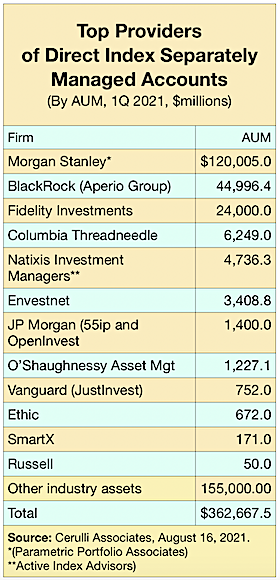

If you’ve taken the famous Myers-Briggs personality inventory test, you may remember that it measured whether you were relatively extroverted or introverted, sensory or intuitive, thinking or feeling, and judging or perceiving—traits identified a century ago by psychoanalyst Carl Jung.
Wade Pfau, who heads the doctoral program in retirement income at The American College of Financial Services, takes a similarly scientific approach to his field. He and colleague Alex Murguia have developed questionnaires to help advisers to understand the personalities of older clients.
These questionnaires, in theory, can reveal clients’ attitudes toward the value of financial advice itself, and their tolerance for risk in retirement. The results, Pfau believes, can help advisers deliver the appropriate kind of advice in the appropriate way to each client.
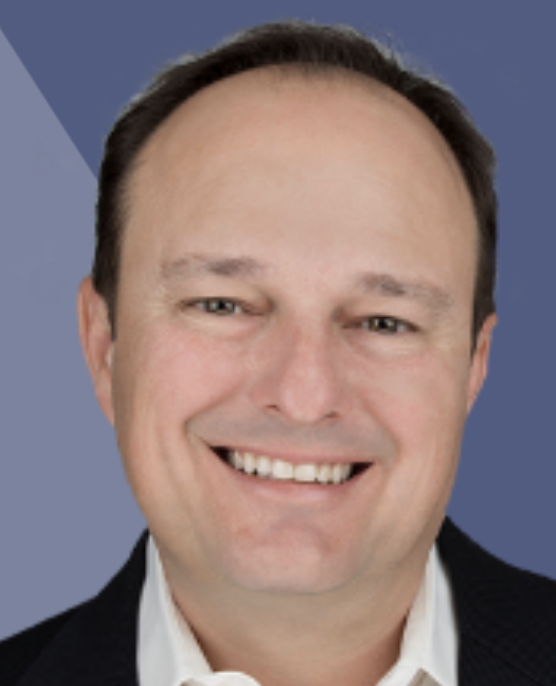
Alex Murguia, Ph.D.
Pfau describes this approach in rigorous detail in two academic papers that he and colleague Murguia published earlier this year. Murguia is a Ph.D. and CEO at RetirementResearcher.com, the web platform that Pfau established for blogging and entrepreneurial ventures.
This work is grounded in their beliefs—which RIJ shares but which may not be universal—that income planning differs significantly from accumulation-stage planning, that no two retirees are alike, and that retirees’ preferences, not advisers’ preferences, should determine their income-generation strategy.
In the paper titled, “A Model Approach to Selecting a Personalized Retirement Income Strategy,” Pfau and Murguia describe a four-quadrant chart that they call the “Retirement Income Style Awareness Matrix.” It’s a kind of Morningstar style-box for matching clients with income strategies.
Within this framework, the authors assume that retirees have four basic financial concerns, whose weight varies by client: Longevity (outliving savings), Lifestyle (maintaining a desired standard of living), Liquidity (having cash for emergencies), and Legacy (leaving a bequest).
The next step in developing an accurate style box is to determine the client’s Retirement Income Style, using a proprietary questionnaire. The clients’ answers reveal their mindsets on six different (and somewhat self-explanatory) scales:
Since a few of these 12 factors are closely correlated, Pfau and Murguia reduce the list to four preferred orientations (Safety First, Optionality, Commitment, and Probability-Based) leading to four styles: Safety-First & Optionality, Probability-Based & Optionality, Safety First & Commitment, and Probability-Based & Commitment,
Finally, the authors map these four styles to four income strategies (boiled down from 36 valid strategies that Pfau identified in past research): Systematic withdrawals from a total return portfolio; time-segmentation (bucketing); partial annuitization; or “risk wrap” (the use of deferred annuities with lifetime income benefit riders).
Here’s what the Retirement Income Style Awareness Matrix looks like:
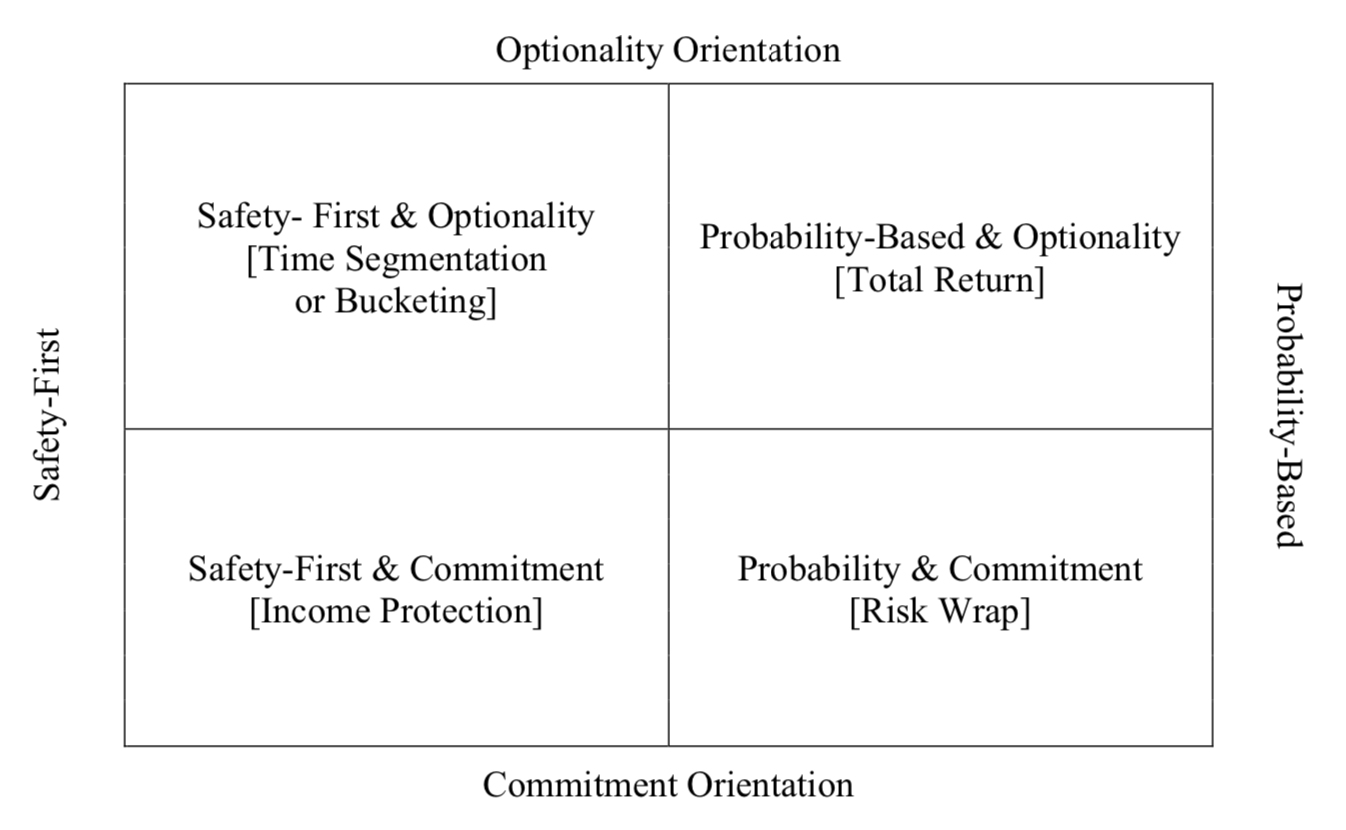
Pfau and Murguia apply a similar method to the creation of a “Financial Implementation Matrix,” which they describe in a paper titled, “Retirement Income Beliefs and Financial Advice Seeking Behaviors.” This matrix assigns clients to one of four groups based on their answers to questions designed to elicit their attitudes toward financial advisers and the value of advice.
A questionnaire leads to scores on six characteristics:
Based on his or her score, each client can be categorized as a Delegator, Collaborator, Validator, or Self-Directed. Delegators and Collaborators both see advisers as useful, but Collaborators score higher on Self-Efficacy. Validators and Self-Directed are skeptical of the value of working with an adviser, but the Self-Directed have higher Self-Efficacy.
Here’s what the Financial Implementation Matrix looks like:
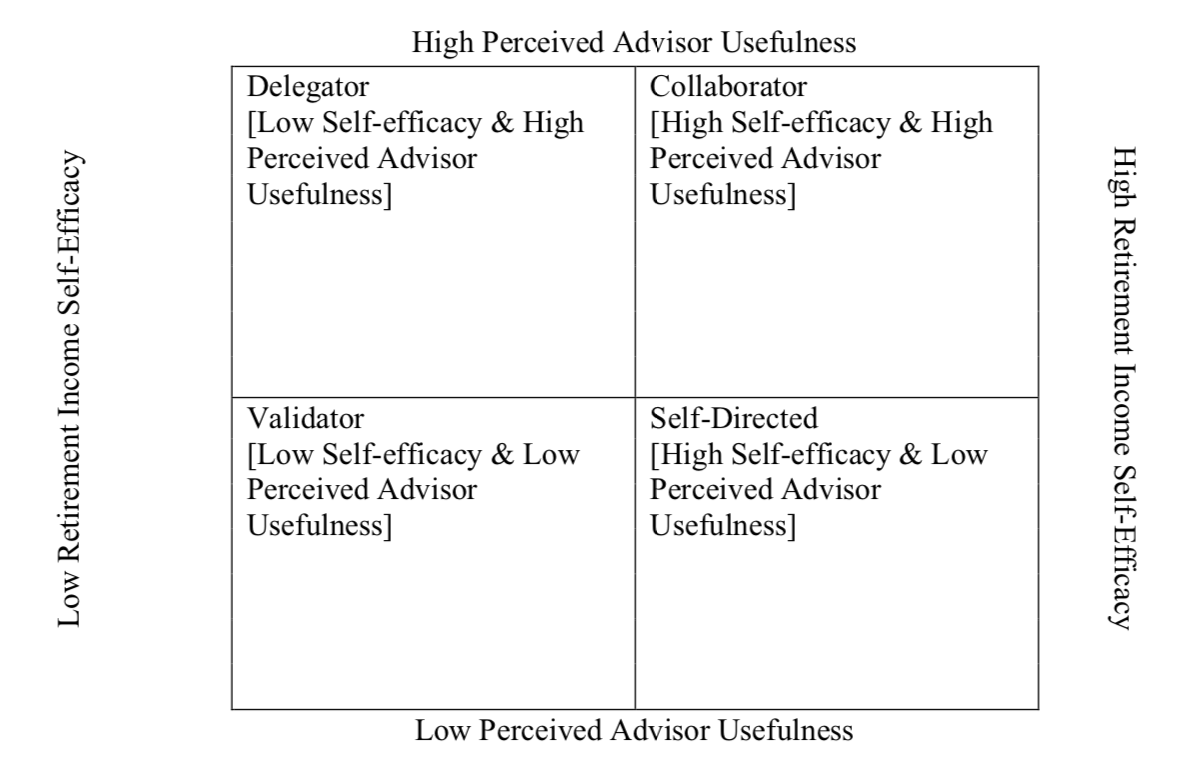
The better advisers understand the client, the better they can fine-tune their approach. “A delegator and a collaborator need a different cadence with their advisor for the relationship to be productive. In addition, a validator and self-directed investor may need different options that do not require an ongoing professional relationship,” the authors wrote.

Wade Pfau
This fine-tuning leads to more effective advice, and more success for everyone involved. “For a financial professional, the ability to present advice in a manner that resonates with an individual is paramount to a successful relationship. More importantly, it will help them follow through with their retirement income plan,” the paper said.
These two papers, and the trademarked intellectual property (RISA and FI) they describe, are not ready-to-implement tools. Rather they are descriptions of the research that Pfau and Murguia used to validate that property, which they have already begun to turn into a business and to market to advisers through webinars. “We are in the process of creating a business for this. We are doing a build-out for it now,” Pfau told RIJ in an email this week.
In addition to drawing on the relevant academic literature, their original research consisted of the surveying some 1,500 subjects, drawn largely from the subscribers to Pfau’s blog at RetirementResearcher.com. More than half of these subjects ranged from 59 to 70 years old and half had investable assets of between $1 million and $3 million. The results of those surveys enabled them to build the matrices or style charts.
Pfau and Murguia’s approach will probably appeal most to independent advisers who are what RIJ has called “ambidextrous.” That is, advisers who know how to lever the complementary benefits of investments and annuities, and who aren’t confined by their business models to a certain set of retirement income strategies.
Advisers won’t be surprised to hear that effective advice demands listening to clients as much as leading them. “Forcing the ‘wrong’ strategy on someone is not appropriate,” the authors write. “There are dangers to initially filtering strategies based on a financial professional or an investment media pundit’s world view rather than seeking to better understand what strategies resonate with an individual’s retirement income style.”
© 2021 RIJ Publishing LLC. All rights reserved.

Click, below, to hear the replay of the interview.
The ‘Bermuda Triangle’ strategy is a business model that several publicly held life/annuity companies in the US have used in recent years, and on which RIJ has been reporting over the past 12 months.
The three corners of the triangle are a life insurer, a reinsurer (possibly “captive”; typically in a regulatory haven like Bermuda, Vermont or Arizona), and an asset manager with experience originating specialized loans.
The reinsurance helps life insurers move stressed annuity liabilities off of their balance sheets, which releases capital for use in new businesses or for share repurchases. The asset manager’s skills deliver higher returns on at least part of the assets backing the reinsured annuities.
Some observers, including regulators, worry about the quantity and quality of the assets held by the reinsurers. They even worry that risk is growing in the annuity space, possibly leading to a solvency crisis in the future.
In this audio, broadcast August 10 on Chuck Jaffe’s Money Life Show, RIJ editor and publisher Kerry Pechter speaks with Jaffe about the Bermuda Triangle strategy and its implications.
A half-dozen life/annuity insurance companies—AIG, American Equity, Brighthouse Financial, Equitable, Lincoln Financial, MetLife released their second quarter 2021 earnings reports this week.
The reports reflect a variety of ongoing trends: Year-over-year increases in individual annuity sales, continuing stock repurchase plans, a shift toward higher-yielding investments in private or alternative assets, alliances with asset managers that source those investments, and new capital management strategies.
Lincoln Financial Group (NYSE: LNC) reported net income for the second quarter of 2021 of $642 million, or $3.34 per diluted share available to common stockholders, compared to a net loss in the second quarter of 2020 of $(94) million, or $(0.49) per diluted share available to common stockholders.
Operating revenues increased in all four business segments. Second quarter adjusted income from operations was $608 million, or $3.17 per diluted share available to common stockholders, compared to adjusted income from operations of $187 million, or $0.97 per diluted share available to common stockholders, in the second quarter of 2020.
Annuities sales of $3.2 billion, up 28%
Annuities reported income from operations of $323 million, up 36% compared to the prior-year quarter. The increase was driven by higher account values from strong equity market performance and favorable returns within the company’s alternative investment portfolio.
Total annuity deposits of $3.2 billion were up 28% from the prior-year quarter. Total variable annuity sales of $3.0 billion were up 37% versus the prior-year quarter as strong growth in variable annuity sales without guaranteed living benefits more than offset declines in variable annuity sales with living benefits and fixed annuities.
Net outflows were $297 million in the quarter. Average account values for the quarter of $166 billion were up 24% over the prior-year quarter, with 48% of total annuities account values without guaranteed living benefits, up 2 percentage points over the prior-year period.
Retirement plan services
Retirement Plan Services reported income from operations of $62 million, up 107% compared to the prior-year quarter. Total deposits for the quarter of $2.8 billion were up 21% compared to the prior-year quarter driven by double-digit growth in both first-year sales and recurring deposits.
Net flows totaled $517 million for the quarter and $1.6 billion over the trailing twelve months. Average account values for the quarter of $94 billion were up 28% over the prior-year quarter.
Retirement Plan Services deposits of $2.8 billion, up 21% including double-digit growth in both first-year sales and recurring deposits
American Equity Investment Life Holding Company (NYSE: AEL), a specialist in fixed index annuities (FIAs) today reported second quarter 2021 non-GAAP operating income1 available to common stockholders of $93.8 million, or $0.98 per diluted common share, compared to non-GAAP operating income1 available to common stockholders of $93.1 million, or $1.01 per diluted common share, for second quarter 2020.
The year-over-year increase in quarterly non-GAAP operating income1 available to common stockholders primarily reflected a decrease in the change in the liability for future policy benefits to be paid for lifetime income benefit riders (LIBR) offset by a decrease in investment spread and an increase in other operating costs and expenses.
Year-over-year, the change in liability for future policy benefits to be paid for LIBR decreased by $61 million. The positive difference between actual versus modeled expectations in the second quarter of 2021, primarily reflecting the level of equity index credits, reduced the increase in the liability for future policy benefits to be paid for LIBR by $29 million. By comparison, in the second quarter of 2020, actual versus modeled expectations increased the change in liability for future policy benefits to be paid for LIBR by $43 million.
Compared to the second quarter of 2020, amortization of deferred policy acquisition and sales inducement costs decreased $1 million. Actual versus modeled expectations in the second quarter of 2021, primarily reflecting the level of equity index credits, reduced amortization by $31 million. Amortization of deferred sales inducements and policy acquisition costs benefited by $28 million in the second quarter of 2020 from actual versus modeled expectations.
American Equity’s investment spread was 1.95% for the second quarter of 2021 compared to 2.00% for the first quarter of 2021 and 2.39% for the second quarter of 2020. On a sequential basis, the average yield on invested assets decreased by 7 basis points while the cost of money fell by 2 basis points. Adjusted investment spread excluding non-trendable items declined to 1.81% in the second quarter of 2021 from 1.87% in the first quarter of 2021.
Average yield on invested assets was 3.51% in the second quarter of 2021 compared to 3.58% in the first quarter of 2021. The decrease in investment yield was primarily driven by an increase in the average level of liquidity in the investment portfolios of the life insurance companies. The average adjusted yield on invested assets excluding non-trendable items was 3.41% in the second quarter of 2021 compared to 3.47% in the first quarter of 2021.
The aggregate cost of money for annuity liabilities of 1.56% in the second quarter of 2021 was down two basis points from 1.58% in the first quarter of 2021. The cost of money in the second quarter of 2021 was positively affected by 4 basis points of over-hedging of index-linked credits compared to 2 basis point of hedge gain in the first quarter of 2021.
Compared to the first quarter of 2021, gross sales of fixed index annuities at American Equity Life increased 36% while Eagle Life sales rose 24%.
Commenting on sales, Anant Bhalla, CEO of American Equity, said in a release: “Our strategy of growing fixed index annuity sales is working in both the American Equity and Eagle Life channels. As previously shared in our first quarter earnings call, our plan to pivot from multi-year fixed rate annuities for the remainder of the year to our refreshed line-up of fixed index annuities is bearing results. Based on preliminary industry estimates, this is the third quarter in a row that our fixed index annuity market share has increased, reflecting the upgrades we have made to our Go-to-Market franchise over the past year.”
In July, American Equity completed the repurchase of 9.1 million shares that began in November of last year to fully offset the impact of dilution from shares issued to Brookfield Asset Management Inc. The total buyback included repurchase of 3 million shares in the second quarter for a total of $95.1 million. Remaining share repurchase authorization is $236 million.
Brighthouse Financial, Inc. (Nasdaq: BHF) announced today its financial results for the second quarter ended June 30, 2021.
The company reported net income available to shareholders of $10 million in the second quarter of 2021, or $0.11 per diluted share, compared with a net loss available to shareholders of $1,998 million in the second quarter of 2020.
During the quarter, as a result of market performance, the value of our hedges decreased, as expected. Due to being accounted for as insurance liabilities as required under US GAAP, certain corresponding liabilities are less sensitive to market movements and, therefore, did not fully offset the decrease in the value of our hedges.
The company ended the second quarter of 2021 with common stockholders’ equity (“book value”) of $14.8 billion, or $175.19 per common share, and book value, excluding accumulated other comprehensive income (“AOCI”) of $10.2 billion, or $120.62 per common share.
For the second quarter of 2021, the company reported adjusted earnings of $435 million, or $5.05 per diluted share, compared with adjusted earnings of $11 million, or $0.11 per diluted share, in the second quarter of 2020.
Annuity sales increased 25% quarter-over-quarter and 8% sequentially, driven by record sales of Shield Level annuities and variable annuities with FlexChoice Access. Life sales increased 117% quarter-over-quarter and 13% sequentially, driven by sales of SmartCare.
During the second quarter of 2021, the company repurchased $125 million of its common stock, with an additional $53 million of its common stock repurchased, on a trade date basis, through August 4, 2021. Since the announcement of its first stock repurchase authorization in August 2018, the company has repurchased $1,266 million of its common stock, on a trade date basis, through August 4, 2021.
The company also announced today a new repurchase authorization of up to $1 billion of its common stock. This stock repurchase authorization is in addition to the $200 million stock repurchase authorization the company announced in February 2021, under which $34 million remains as of August 4, 2021.
“Brighthouse Financial delivered another quarter of strong results,” said Eric Steigerwalt, president and CEO, Brighthouse Financial. “Our new stock repurchase program… positions us to achieve our goal of returning $1.5 billion to our shareholders by the end of this year and supports our ongoing commitment to return capital to our shareholders.”
Adjusted earnings for the quarter reflected a $23 million after tax unfavorable notable item, or $0.27 per diluted share, for establishment costs related to planned technology and other expenses associated with the company’s separation from its former parent company. Corporate expenses in the second quarter of 2021 were $218 million, up from $203 million in the first quarter of 2021, both on a pre-tax basis.
Commenting on investment activities, Anant Bhalla, Chief Executive Officer, said: “For the first time in our company’s history, in the second quarter, we started leveraging our asset management partnerships to invest in single-family rental homes and middle market loans consistent with ramping towards the AEL 2.0 asset allocation strategy.
“Year-to-date, we have purchased over $800 million of privately-sourced alpha-generating assets — solid initial steps towards our plan of adding between $1 billion to $2 billion in private assets this year growing to a pace of 5% or greater of the portfolio in each subsequent year to evolve into our new asset allocation of 30% or greater in private assets. In the second quarter, we purchased $1.7 billion of new assets at an expected return of approximately 4.15%, net of third-party investment expenses. This included $569 million in private assets added in the quarter.”
Equitable Holdings, Inc., (NYSE: EQH) today announced financial results for the second quarter ended June 30, 2021. The company reported non-GAAP operating earnings of $1.71 per share, a 74% increase year-over-year and 27% over the first quarter, AUM of $869 billion, up 22% year-over-year and 6% over the first quarter of 2021.
“We achieved the successful closing of our landmark VA reinsurance transaction with Venerable during the quarter, which significantly de-risks our balance sheet and unlocks $1 billion of economic value. We are targeting an additional $180 million in incremental investment income from our General Account by leveraging synergies with our subsidiary, AllianceBernstein. We are also announcing a new expense savings target of $80 million by 2023.” said Mark Pearson, President and Chief Executive Officer.
The net income attributable to Holdings for the second quarter of 2021 was $123 million compared to net loss of $4,019 million in the second quarter of 2020 driven primarily by non-economic market impacts from hedging and non-performance risk under US GAAP accounting.
Non-GAAP operating earnings in the second quarter of 2021 improved to $758 million from $451 million in the second quarter of 2020. Excluding notable items of $100 million, second quarter 2021 non-GAAP operating earnings were $658 million or $1.48 per share.
As of June 30, 2021, book value per common share, including accumulated other comprehensive income (“AOCI”), was $24.20. Book value per common share, excluding AOCI, was $19.48.
Business segment highlights:
Structured Capital Strategies (“SCS”) buffered annuity product saw record sales of $1.9 billion in the second quarter. Group Retirement generated second quarter net flows of $68 million, up $119 million sequentially, with gross premiums returning to pre-pandemic levels in the second quarter. Investment Management and Research (AllianceBernstein or “AB”)3 reported net inflows of $6.2 billion in the quarter, with positive net flows across all distribution channels. Protection Solutions reported gross written premiums up 8% year-over-year, with continued momentum in its Employee Benefits business.
Capital management program:
As part of the Company’s 2021 capital management program, it returned $355 million to shareholders in the second quarter, including $76 million of quarterly cash dividends and $279 million of share repurchases.
The Company reaffirms its commitment to delivering on its 50-60% payout ratio target, with an incremental $500 million of share repurchases in progress following the close of its legacy variable annuity reinsurance transaction with Venerable.
As part of its efforts to leverage synergies, the Company is committing $10 billion of General Account assets to help build out AllianceBernstein‘s higher multiple businesses.
The Company also announced an expense savings target of $80 million by 2023, with $17 million achieved year-to-date, driven by disciplined expense management, shifting towards an agile working model and leveraging technology-enabled capabilities.
As of June 30, 2021, the combined RBC ratio was approximately 450%, above our minumum combined RBC target of 375-400%. The Company reported cash and liquid assets of $2.5 billion at Holdings, which remains above the $500 million minimum liquidity target.
The Company announced a GA rebalance target of $180 million of incremental income by 2023, working with AB to capture illiquidity premium and optimize risk-adjusted returns for the investment portfolio. Of the target, $58 million has been realized to date.
MetLife reported net income of $3.4 billion, or $3.83 per share, compared to net income of $68 million, or $0.07 per share, in the second quarter of 2020. Adjusted earnings of $2.1 billion, or $2.37 per share, compared to adjusted earnings of $758 million, or $0.83 per share, in the second quarter of 2020. In other highlights:
© 2021 RIJ Publishing LLC.

China represents a significant opportunity for asset managers, according to Cerulli Associates’ latest report, Global Markets 2021: Continued Growth in Uncertain Times. Assets under management in China grew 34.0% in 2020 and net inflows increased 21.8% year-on-year, the report said.
The Chinese fund market had an impressive 2020, with net revenues rising 37% year-on-year, Cerulli’s research shows. This growth was supported by strong local equities—the MSCI China recorded a 29.7% return last year, exceeding its 23.7% return in 2019.
The COVID-19 pandemic has not dampened investors’ enthusiasm for the Chinese mutual fund industry. Chinese regulators are pushing for the development of funds investing in equities, including fast-track approval for equity-related fund applications submitted by fund management companies that score higher under the scorecard method introduced in late 2019.
“We expect investors to show continued interest in Chinese equities in 2021 and beyond, based on the country’s earlier recovery from the pandemic and its growth prospects relative to other markets,” said André Schnurrenberger, managing director, Europe at Cerulli Associates. “As for bonds, investors are set to favor Asian fixed income because it currently offers better yields than bonds in developed markets.”
Cerulli expects Asia ex-Japan retirement funds to continue to lead in terms of growth, rising at a compound annual growth rate (CAGR) of 11.9% between 2020 and 2025. Although all markets in the Asia-Pacific region will likely exceed the global CAGR, China and Korea stand out, with their CAGRs expected to reach double digits.
At least 1,300 funds were launched in China in 2020, amassing RMB3.1 trillion (US$475 billion) in assets from their initial public offerings. In India, the second wave of the pandemic, which hit the country in March 2021, could see cautious investors favoring safe and liquid assets; other investors may use market corrections as opportunities to allocate to mutual funds. COVID-19 may also encourage increased saving.
In non-Asian developed markets, pension funds are looking to opportunities in Asia. Canadian pension funds, including the Canada Pension Plan Investment Board and Ontario Municipal Employees’ Retirement System, have been growing their Asia-focused teams to match their expanding investments in the region. In addition, the Nationwide Pension Fund in the UK and the Iowa Public Employees’ Retirement System in the US have indicated their interest in including more Asian private debt in their portfolios.
“Investors around the world believe that emerging markets, particularly in Asia, are making better progress in their economic recovery from COVID-19. As a result, they are keen to increase their exposure to such markets,” Schnurrenberger said.
© 2021 RIJ Publishing LLC.
Ruark Consulting, the actuarial firm that has tracks the impact of policyholder behavior on the value of the liabilities in the living benefits of variable annuities issued by US life/annuity companies, has just published a white paper assessing the predictions it made regarding that behavior a year ago.
In the white paper, Ruark concluded:
When we assessed the effects of the capital market environment on annuity policyholder behavior toward the end of 2020-Q1, markets had just suffered a major blow. The S&P 500 had fallen over 35%, as had commodity prices. The VIX, a measure of implied volatility on short-dated options, had spiked, and US interest rates had fallen to record lows.
Today, equity markets have rebounded and volatility has fallen. But a hangover effect of COVID-19 remains, as supply and labor shortages drive and inflation concerns, while interest rates have not materially recovered.
Notwithstanding a rebound in 2021-Q2 annuity sales, these hangover effects continue to pose challenges for annuity writers, as does continued uncertainty regarding government policy and the management of variant virus strains. Annuity writers may wish to defer decisions regarding how to best reflect 2020 experience in assumption-setting—but as the effects of the virus push into 2021, such decisions cannot be put off indefinitely.
In the case of VA and FIA products, which are not subject to individual underwriting, mortality has exhibited strong anti-selection effects. Historically, mortality has been lower among policyholders with a living benefit than among those without, for example. This would suggest potentially higher susceptibility to a health shock among policyholders with only a GMDB than among living benefit contracts.
One last question annuity writers need to consider is mortality improvement in 2021 and beyond. Was COVID-19 a once-in-a-century pandemic, or will ongoing variants and pandemic-related mortality spikes become a feature of the landscape? Were 2020 mortality increases on top of the long-term trend, or did they merely accelerate deaths among vulnerable populations? Answers these questions will continue to be speculative, but 2020 experience will surely inform them. We look forward to seeing the evidence upon completion of Ruark’s 2021 VA mortality study this fall.
DPL Financial Partners (DPL), the turnkey insurance platform for registered investment advisors (RIAs), and SS&C Technologies Holdings, Inc. (Nasdaq: SSNC) have co-launched a new platform, called the “SS&C Advent Insurance Marketplace Powered by DPL.”
RIAs can use this fintech solution to access and manage fee-only products through the Black Diamond Wealth Platform and DPL’s proprietary Product Discovery Tools. Products include
annuities, life insurance, long-term personal care, and disability insurance. DPL’s insurance consultants will provide product support.
DPL’s partner insurance carriers with products on the new platform include who are making their products available through the Marketplace, including Allianz Life Insurance Company of North America, Great American Life, Security Benefit Life, and Midland National Life.
SIMON Markets LLC, a platform where advisors can find structured products, annuities, and other alternative investments, reported year-over-year increases in revenue of +103%, volume of +137%, and usage of +74% in Q2 2021, as compared to Q2 2020.
“In Q2, we expanded our insurance platform to include variable annuities, formalized new partnerships with industry leaders Nationwide and FIG, created a portfolio analytics tool for structured investments, and announced our entry into the digital asset space,” said Jason Broder, CEO of SIMON, in a release.
SIMON was spun out of Goldman Sachs in December 2018. Recent growth highlights include:
SIMON’s platform now provides “on-demand education, an intuitive marketplace, real-time analytics, and lifecycle management” to more than 100,000 financial professionals managing some $5 trillion in client assets, the release said.
Principal Financial Group, the retirement plan services and investment management company, recently completed the integration of the Wells Fargo Institutional Retirement business. Principal acquired the business in July 2019 to enhance its retirement and income capabilities, achieve greater scale and balance, and drive business growth.
Through the acquisition and new business wins, Principal currently serves over 10 million eligible participants and individual account holders representing more than $537 billion in total account value.1 Principal also added to and upgraded its retirement service offerings, furthering its market leadership positions in the full spectrum of retirement plans with Principal® Total Retirement Solutions and including top-tier investment, income and financial wellness offerings.
As a result of the acquisition Principal added 4.3 million eligible participants, approximately $150 billion dollars in account value and welcomed 1,500 new employees. The company onboarded clients in a series of structured waves through the end of June 2021, resulting in the successful integration of thousands of plan sponsors.
The integration of the Wells Fargo Institutional Retirement and Trust business along with strategic investment and initiatives has enhanced and expanded the retirement offerings Principal provides to both participants and plan sponsors.
In October of 2020 Principal started welcoming participants through Principal Real Start, a simplified and highly personalized onboarding experience available in both English and Spanish. This platform has helped increase savings rates for participants to an average of about 9 percent, and nearly 40 percent of participants are deferring 10 percent or more.2
Participants are also benefitting from a more robust financial wellness experience through award-winning online tools3 and resources backed by specialized teams of education professionals and contact center licensed financial professionals.4
For plan sponsors, enhancements include more robust plan sponsor reporting and participant engagement dashboards.
Sponsors also have access to new managed and self-directed brokerage account capabilities.
The retirement business expanded Principal® Total Retirement Solutions, which provides unmatched breadth, depth, and expertise for plan sponsors of all sizes and needs. These solutions include defined contribution plans, defined benefit plans, nonqualified deferred compensation plans, and stock plans including the recently added Principal® Equity Compensation Solutions.
Today, Principal Total Retirement Solutions helps thousands of employers manage multiple retirement plans.
After moving to Principal, customers now have access to top-tier, differentiated asset allocation and managed account alternatives from Principal, both in plans and for individual participants. Principal offers extensive choice across investment strategies and managers, including a full suite of actively managed and hybrid target-date funds that help meet customers’ unique investment and retirement needs.
Principal continues to integrate the Wells Fargo Trust & Custody business from the acquisition, which will enhance and add new capabilities to Principal® Custody Solutions and increases assets under custody to over $1 trillion. The company plans for completion of the integration by March 2022.
The Center for Board Certified Fiduciaries (CBCF) introduces Fiduciary Oversight of Responsibilities and Tasks (FORT), “a new tool for professional and lay fiduciaries that clearly delineates the fiduciary responsibilities and tasks of a plan sponsor,” according to a release this week.
There are 17.5 million lay fiduciaries in the US, men and women who have the legal responsibility for managing the assets of pension plans, foundations, endowments, health and welfare plans, and personal trusts. Three million lay fiduciaries manage $20 trillion dollars in retirement plans.
“These critical decision-makers generally come from outside the financial services industry; are often surprised to learn they are serving in a fiduciary capacity; and, have little, if any, training on what the law requires,” the release said.
“Lay fiduciaries don’t have to manage these assets by themselves – they can prudently select experts and delegate certain responsibilities. But often, there’s no bright-line between the fiduciary responsibilities lay fiduciaries retain, and the responsibilities that are contractually assumed by experts.”
The Board Certified Fiduciary (BCF) is a professional mark awarded by the Center for Board Certified Fiduciaries, (CBCF). The CBCF is a Public Benefit Corporation founded and funded by fiduciary advocates. The CBCF will be affiliating with a leading university to provide a graduate-level certificate in fiduciary leadership, stewardship, and governance. Over time, CBCF will develop the curricula for the first Master’s with a concentration in fiduciary responsibility.
© 2021 RIJ Publishing LLC. All rights reserved.

The “gold standard” died 50 years ago this week. I witnessed the execution, in a sense, and I’ve spent a fair amount of time since then trying to understand what happened, why, and how well it explains today’s economy.
The date was August 16, 1971. The scene was a provincial bank in France. I had pedaled north from Fontainebleau that morning, following the Seine to Paris. At the outskirts of Melun, I leaned my bike with its saddlebags against a stone wall outside the bank and walked inside.
The teller seemed flustered, even panicky. Richard Nixon had taken dollar “off gold” the day before; she wasn’t sure how many francs to exchange for my $20 travelers check. Eventually, calmer, she gave me about four francs per dollar—the usual rate. I countersigned my check, pocketed the money and left.
“Bretton Woods,” and the eponymous financial treaty that the US had just broken, didn’t mean anything to me at the time. I had just spent ten picaresque weeks in southern Europe on a budget of about $10 a day, vaguely aware of why everything was so cheap. The future—the oil crisis and the “stagflationary” 70s—was still over the horizon.
A whistle-stop in New Hampshire

Mount Washington Hotel
Bretton Woods is a section of Carroll, New Hampshire, and the home of the still elegant Mount Washington Hotel. That’s where, in July 1944, to escape the swelter of Washington, DC, for the cool White Mountains, the world’s finance ministers met to replace an international monetary system whose perverse incentives helped cause two world wars in 30 years.
Or, rather, the ministers came to rubber-stamp the new dollar-based regime, designed mainly by the Roosevelt administration. Given America’s economic strength and the fragility of Britain’s empire near the end of World War II, America was in a position to replace England as the world’s economic leader and the dollar to replace the pound as the world’s “reserve” currency.
The dollar became a proxy for gold and a benchmark for all other currencies. Under the Bretton Woods agreement, the US (with 55% of the world’s yellow bullion) was the only country that would exchange its money for gold on demand from foreign central banks. Dollars, backed by about $25 billion in gold, would and did help finance the economic recovery of a war-whacked world.
The boom—including the Baby Boom—lasted through the mid-1960s. By then, deep-pocketed Uncle Sam eventually spread so many dollars around the world (via wars and imports) that it couldn’t afford to keep releasing ounces of gold for only $35—at least, not without cutting spending on Vietnam, raising interest rates, cutting imports, clamping controls on domestic wages and prices, and throwing the US economy into recession. With his eye on re-election in 1972, Nixon threw the gold standard under the bus instead of the US economy.
In his 1981 book, The Money Lenders, Anthony Sampson summarized the financial sea-change:
“The supremacy of American bankers was already questioned by the end of the sixties, as the balance of financial power was shifting. The world’s confidence in the dollar, which lay at the basis of the Bretton Woods agreement, was undermined by the Vietnam War. The long boom of the West was faltering, with too much capacity and too little employment. The pound was devalued in 1968 followed by other currencies, which in turn undermined the strength of the dollar. American manufacturers were losing out against Europe and Japan; Japanese cars were beginning to roll into America. The United States showed a [trade] deficit for the first time since 1893.” US gold reserves stabilized after slipping to about $10 billion in 1968, but the antagonism between the gold standard and the expansion of US spending was set.
“The Nixon administration tried to hold up the dollar but by 1971… they ‘had either lost or abandoned any semblance of control of the situation’; and they finally decided to force devaluation on the others. The western finance ministers at the Smithsonian Institution in Washington legitimized what the market had already decided, and devalued the dollar against gold… By March 1973 Nixon gave up the attempt to fix the dollar to gold. All western currencies floated up and down freely. The Bretton Woods system had virtually collapsed (p. 118-119).”
That collapse has been well-described and explained in several non-technical books: Closing the Gold Window, by Joanne Gowa; The Way the World Works, by Jude Wanniski, The Fate of the Dollar, by my late uncle Martin Mayer, among others. The most recent may be Kenneth D. Garbade’s 2021 book, After the Accord, an academic history of the Federal Reserve from 1951 to 1979. For events leading up to the Bretton Woods agreement, see Ben Steil’s The Battle of Bretton Woods (2013.)
Garbade, an economist and former senior vice president at the New York Fed, writes that Arthur Burns, who in 1970 succeeded Fed chairman William McChesney Martin (the chair since 1951 and the man who compared the Fed to a “chaperone who has ordered the punch bowl removed just when the party was really warming up”), satisfied Nixon’s demand for lower interest rates to stimulate the economy.
“The decline of rates reversed the flow of gold [to the US Treasury] and exacerbated a cascading series of problems that culminated in Nixon’s decision to close the Treasury’s gold window on August 15, 1971, putting an end to United States gold sales to foreign central banks at $35 an ounce. Within two years, the Bretton Woods system of fixed exchange rates was gone as well, replaced with floating rates.”
Red lights, very cheap
At the time, Europe was still a bargain, especially if you were a young bicyclist or backpacker in southern Europe with no need for things that required money, like fancy dining, lodging or transportation. (Prices in the US in 1971 were roughly 10% of today’s level—the minimum hourly wage was $1.60—but most of Europe was an order of magnitude cheaper.)

From left: Federal Reserve chairman Arthur Burns, Treasury Secretary John Connally and President Richard Nixon.
My biggest single expense that summer was airfare from New York ($250, round-trip). A Peugeot UO-8 10-speed bicycle cost $115. At the very lowest end of the tourist economy, you got very little but you paid nothing for it. The price of a cot, among three or four other cots, in a spare bedroom in an Italian family’s apartment near the Rome train station: 800 lira or $1.
And so forth. A night at the only lodging house (with a staff of one, offering linen but no other amenities) in Arvi, on the southern coast of Crete: 20 drachma or about 60¢. In Holland, a cold green bottle of Heineken with ham-and-cheese on a dinner roll cost less than $1. In Amsterdam’s stoner cafés and even its famous red-light district, 20 guilders or $6 could go a long way.
How do today’s prices compare? Finding out would require a breadth and depth of research that I’m no longer prepared to do. For my purposes here, the more pressing question is, How did the end of Bretton Woods and the gold standard impact the world’s economy?
A 40-year bull market begins
In How the World Works, Wanniski describes how it led to a decade of stagflation—inflation plus low growth. By unmooring the dollar from gold while lowering interest rates and stimulating the economy for political reasons, Nixon added to the inflation that had already been underway. Then a series of hefty political and economic dominos began to fall.
Wanniski, a “supply-side” journalist who championed economist Arthur Laffer’s famous “curve,” noted that inflation drove American’s salaries into higher tax brackets and reduced their spending power, leading to the famous “stagflation” of the 1970s. But more fatal geo-political other-shoes soon dropped.
Precipitously, the oil producers of the Middle East, to offset the falling value of dollars, raised the price of oil, which was fixed in dollars. That event was followed by the oil shortages of 1973, the “Yom Kippur War” between the Arabs and Israelis, Nixon’s resignation from the presidency, and then the recession of 1974-1975, when the Dow dropped to 619 (3264, adjusted for inflation).
On an inflation-adjusted basis, the Dow fell from the present equivalent of about 8000 in 1966 to 2252 in 1982—bottoming out after two or three years during which Fed chair Paul Volcker stopped accommodating the banks’ needs for reserves and allowed the fed funds rate—which today stands at only 0.25%—to climb to 20%.

Gold’s atomic structure
That’s when the post-Bretton Woods fever seemed to break. From that point—the climax of perhaps the greatest stock- or bond-buying opportunity in financial history—the prices of securities began climbing and, with a couple of significant but transitory interruptions, ascended to today’s alpine heights. Many people remember the 1970s as a gloomy time; Warren Buffett probably doesn’t. He scooped up blue-chip bargains.
But it was also the start of the era of widening economic inequality in the US (between those who own a lot of securities and those who don’t), the exponential accumulation of US deficits and debt (the value of outstanding Treasury debt rose to $28 trillion in 2021 from $1.2 trillion at the end of 1982), and the appearance of large trade deficits. Once a major exporter, the US has been the world’s biggest importer for more than 40 years. Once the world’s largest creditor, the US is now the world’s largest debtor.
That makes for a lot of historical dots, and there’s no limit to the number of ways you could connect them. One residual question: How has the dollar managed to remain the reserve currency even after so many trillions of them have been put in circulation worldwide?
We shouldn’t mourn the end of the gold standard. As Keynes noted, digging gold out of the earth, exchanging it for paper at a central bank, and re-burying it in Fort Knox or in a vault under the Federal Reserve Bank of New York never made sense. In any case, there isn’t nearly enough gold in the world to finance today’s global economy. And that’s not the worst aspect of it.
Countless Aztecs, Incas and Africans were enslaved or slaughtered for gold. In the 1940s, Europeans were killed for the crowns and fillings in their teeth. Toxins still bleed from old gold adits in Colorado. Cyanide-laced pools stagnate beside new gold mines all over the world. All because of gold’s intrinsic value: its perfect atomic structure, which makes it ideal for conducting electricity and for making jewelry that never loses its lustre.
© 2021 RIJ Publishing LLC. All rights reserved.
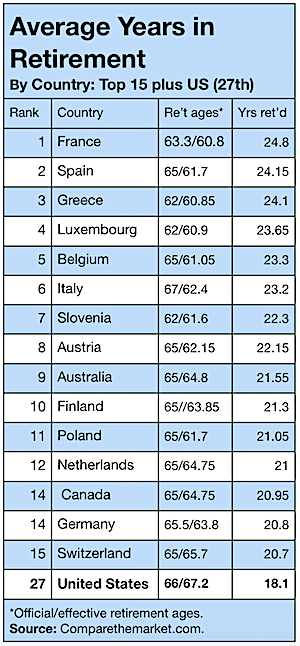
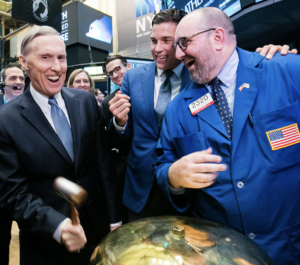
Americans’ retirement savings, either in the form of individual annuity contracts or group annuities funded by defined benefit pension funds, continue to supply a flood of manageable money to the asset management partners of private equity-owned life insurers.
In a “pension risk transfer” (PRT) deal announced this week, for example, Lockheed Martin, the aerospace giant, transferred $4.9 billion in pension obligations—and, presumably, the savings that back them—to Bermuda-based Athene Holding Ltd.
Athene’s subsidiaries, Athene Annuity Life Company and Athene Annuity & Life Assurance Co. of New York, will provide a group annuity to about 18,000 Lockheed Martin retirees currently receiving pension benefits.
The transaction announced this week is the second pension risk transfer transaction Lockheed Martin has signed with Athene. In 2018, Athene insured approximately $800 million in pension obligations for more than 9,000 of Lockheed Martin’s retirees and their beneficiaries.
In its second-quarter 2021 earnings report, issued today, Athene Holding reported assets of $215.5 billion. Yesterday, Apollo Global Management reported assets under management of about $471.8 billion. Last March, the two companies, already closely tied, announced that they would merge. “Athene accounts for about 40% of Apollo’s AUM and generates 30% of its fee-related earnings revenue,” according to a March 25, 2021, report from SP Global Market Intelligence.
In total, Athene said it has partnered with plan sponsors and intermediaries on more than $19 billion of transactions to support more than 300,000 annuitants since it entered the PRT market. In a release, Bill Wheeler, Athene’s president, said the “transaction with Lockheed Martin represents Athene’s largest PRT transaction to date.”
“The Athene group annuity contracts were purchased using assets from Lockheed Martin’s master retirement trust and no additional funding contribution was required as part of this transaction,” a Lockheed Martin release said.
But Athene’s release said it had used its strategic capital vehicle, Athene Co-invest Reinsurance Affiliate (ACRA), “to support the completion of this transaction.” Athene could not be reached for comment before deadline on why Athene would need third-party capital to complete a PRT deal.
A report from Artemis, a publication that covers the insurance industry in Bermuda, said Athene created ACRA in the spring of 2019 and soon funded it with $3.2 billion from third-party investors. According to Artemis:
Athene has built ACRA to give investors the certainty in their time horizon, which in the life space has hindered companies’ ability to get third-party capital onboard. Investors need some certainty in how they can get out of a vehicle, not wanting to be on the hook endlessly for these long-tail transactions. “Investors want to know when is their exit and what does it look like,” [Chip] Gillis [an Athene Holding co-founder, now retired] said, adding, “So that’s been built into it.”
ACRA provides investors with a mid-term allocation horizon with a way to access life and retirement risks in a structure providing the returns they seek, in a way they can see this exit point clearly. Other companies are likely to take notice and see the opportunity to bring in complementary sources of capital, or to tap into new investor groups with different appetites, all while providing an insurance or reinsurance linked return which meets the alternative needs of many institutions mandates.
On Jan. 1, 2022, Athene will begin paying and administering the retirement benefits of certain retirees and beneficiaries in the Lockheed Martin Corporation Salaried Employee Retirement Program and the Lockheed Martin Aerospace Hourly Pension Plan. The transaction will result in no changes to the benefits received by retirees and beneficiaries. Affected retirees and beneficiaries will receive a letter with additional details about the transfer.
This was Lockheed Martin’s fourth PRT deal in about two years. In 2019, MetLife assumed approximately $1.9 billion in pension obligations for about 20,000 of the company’s retirees and their beneficiaries. In 2020, a MetLife subsidiary, Metropolitan Tower Life, assumed about $1.4 billion in obligations for about 13,500 Lockheed Martin retirees and beneficiaries.
In a press release, Lockheed Martin said it expects to recognize a non-cash, non-operating settlement charge of approximately $1.7 billion ($1.3 billion, or $4.75 per share, after tax) in the third quarter of 2021, primarily related to the accelerated recognition of actuarial losses for the affected plans. The actual settlement charge will depend on finalization of the actuarial assumptions, including discount rate and investment rate of return, as of the measurement date, the release said.
Athene’s strategy in acquiring annuity, insurance and pension assets—as well as its penetration of the fixed indexed annuity business, where it is the overall sales leader—has been compared to Warren Buffett’s strategy of buying insurance companies and using the premiums as a source of financing for other ventures.
These premiums are sometimes referred to as “permanent capital”—not because they never get paid back to policyholders but because they are a predictable and stable source of capital. If nothing else, the asset management affiliate of the insurance company earns management and possibly performance fees from managing the money.
“The way to think about Athene is part of the larger Apollo group. Of the assets that Athene gathers through large reinsurance deals, it keeps part in reserve and puts the rest into the investments that Apollo runs. That’s the float. Buffett has $120 or $130 billion in insurance float. He keeps some in case losses arise, and puts the rest to work in the conglomerate. Athene and Apollo have the ability to do that,” explained Steve Evans, the publisher of Artemis.
“The third-party capital piece is more recent,” Evans added. “ACRA is a co-investment facility, designed like an insurance-linked securities (ILS) fund. It takes in capital, and the investors get a share of the profits or losses. It enables Athene to do more with less of their own capital.”
But these deals—not unlike the efforts by broker-dealers to gain 401(k) savings via rollovers to brokerage IRAs—make some industry watchers nervous.
“Permanent capital in private markets will also accentuate the risk of misbehavior in a sector notorious for questionable practices. In the aftermath of the GFC, several PE groups saw their reputations marred by claims of collusion, corruption, and inadequate disclosure of fees charged to capital providers,” wrote Sebastien Canderle, author of “The Debt Trap” and other books, in a recent blogpost at the CFA Institute.
“Their use of float [of annuity and/or pension assets] is clever—but clever on a slippery slope,” said Tom Gober, a Richmond-based forensic accountant who analyzes life insurers, in an interview. “It worries me that the primary focus of the private equity and hedge funds is the accumulation of assets, a focus more on getting money in the door, not on the claims they’ll have to pay to annuitants or pensioners many years down the road.”
Athene has been fined for mis-practices in the past. New York financial regulators on Thursday fined Athene Life Insurance Co. of New York $15 million for not providing required information to about 15,000 life-insurance policyholders from 2015 to 2017, according to a Wall Street Journal story on June 28, 2018.
The violations occurred after First Allmerica Financial Life Insurance Co., a unit of Global Atlantic Financial Group, agreed to administer many of Athene’s life-insurance policies in 2013. FirstAllmerica also provided reinsurance for the policies. The types of policies impacted included universal life, whole life and term life.
As part of Thursday’s agreement, First Allmerica also agreed to make remedial efforts totaling about $40 million, including waiving some back premiums or extending payments for policyholders who didn’t receive notices, New York’s Department of Financial Services said.
In April 2020, SPGlobal reported that the New York State Department of Financial Services fined Athene Holding Ltd. and unit Athene Annuity & Life Co. $45 million related to a probe into the subsidiary’s unlicensed pension risk transfer business in the state.
The regulator noted that Athene Annuity & Life entered into 14 pension risk transfer transactions and engaged in thousands of unauthorized communications with New York-based plan sponsors.
© 2021 RIJ Publishing LLC. All rights reserved.

Retirement communities come in many flavors. Some communities are designed to help people ride into the metaphorical “sunset” of old age. These communities cater mainly to those in the slow-go or no-go stages of retirement.
Other communities, often in Rockies, or the Adirondacks or Berkshires or Northern Michigan, are designed more for those still in pre-retirement, or in the go-go stage of retirement, who want to ride an actual horse into an actual sunset. Or, as they get older, an ATV.
I’ve visited one example of that second kind of community a half-dozen times over the past decade. Until recently, friends of mine owned a share in one of fifteen cabins at a former dude ranch, converted to a homeowner’s association, in a remote valley in central Colorado.
This Shangri-La, whose exact location I won’t disclose, sits on a dry patch of table land in a cradle of forested hills and treeless peaks. A river runs through it. The neighbors, aside from other cabin owners, are hummingbirds, deer, beaver and occasionally a moose or bear.
Many people dream of retiring to such a place. But, delightful as it may sound, it’s not for everyone. You need time, wealth, and health in order to make the dream real. And even those who come don’t necessarily stay long.
Time is essential. You need to be either retired, or live in within a half-day’s drive (e.g., Denver, Taos, etc.) or be a teacher with idle summers in order to take advantage of owning a cabin in central Colorado. If you live in Tennessee, Texas, or Hawaii, as some residents do, you’ll need to spend a month or two at the cabin in order to justify the time you spend getting there (and the time spent earning money to buy the cabin). You must visit during the summer, when the cabins are not snowed-in and the road is passable; this isn’t a ski village.
Wealth makes ranch life easier. These cabins are second and sometimes third homes, after all. The structures themselves are not expensive, but they are neither large nor luxurious. There is no electricity unless you put up solar panels. The only other power source is propane—to run the well pump, heat water, and a gas-fueled refrigerator.
One of the original dude ranch cabins is currently on offer for $60,000, but it has only one bedroom, a sitting room/kitchen, and small bathroom. A newer cabin next door, to which a marine biologist from Hawaii recently added a second-floor loft, lists for $275,000. Do not expect to change your mind and flip your cabin. A couple of the older cabins, priced at $125,000, have sat on the market for years. If you’re tallying expenses, you might also include the potential costs of toys: horses, snowmobiles, and ATVs, as well as trailers for each of them. Under HOA rules, you may not rent your cabin, but you may have guests.

Just another trout stream in Colorado.
Your neighbors here will vary in wealth and status and the degree to which they upgrade their cabins. There’s a couple from the East who owned a lubricant packaging firm. There’s a second-marriage couple from New Mexico, both retired from government jobs with ample pensions. A charter-school teacher and his family recently bought a cabin. The original owner of the dude ranch, who built a sprawling log chalet on the property, is a retired Fortune 500 executive.
To be truly happy owning an isolated cabin in an HOA, it helps to be gregarious. Cocktails on a neighbor’s porch may be the only evening entertainment. A willingness to tolerate and obey annoying HOA rules is important too. An enduring passion for the wilderness is essential, as is a certain level of fitness.
Without health in your 60s, you’re at risk of reaching the slow-go stage as soon as you stop working. You don’t need to be a 65-year-old marathoner to enjoy summers in the Rockies. One long-time resident, morbidly overweight, passes his time rocking on his porch or shooting at the beaver whose dam floods the cattle grid on the road into the ranch.
Another resident needed to install solar panels to power his CPAP machine, but he still fly fishes in the three trout streams that flow from the Continental Divide. But you’ll get much more out of cabin ownership if you have enough lung capacity and muscle mass to hike into the thin air of the surrounding foothills and mountains.
As people get older, they naturally downshift from hiking to horses to driving an ATV. No family seems to keep a cabin indefinitely. Grown children may visit, but they aren’t likely to want to inherit a cabin and keep the tradition alive. It’s more common (as my friends did) to let the cabin go to be closer to grandchildren.
Colorado is almost but not quite Shangri-La, the fictional Himalayan village where no one grows old or dies unless they leave. The cabins are several hours away from the nearest large hospital. But we don’t need to discuss that now. After the rains in July, the wildflowers bloom and the meadows above the cabins become a kind of heaven.
© 2021 RIJ Publishing LLC. All rights reserved.
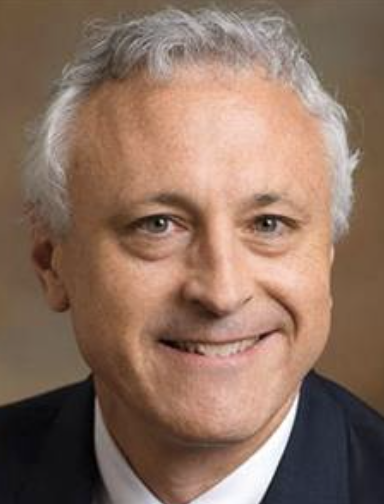
The CEO and chairman of T. Rowe Price Group, Bill Stromberg, will retirement from his roles at the company on December 31, 2021, and will be succeeded on the following day by Rob Sharps, T. Rowe Price’s current president, head of investments and group chief investment officer.
Of the “big three” providers of target date funds to corporate retirement plans, only T. Rowe Price is a publicly held company. Regarding the other two, Fidelity is privately owned and Vanguard is a cooperative. Traditionally, Baltimore-based T. Rowe Price has specialized in actively managed mutual funds, while Vanguard has focused on passively managed index funds. All three companies are leading full-service retirement plan providers.
At December 31, 2020, T. Rowe Price had $1,470.5 billion in assets under management, including $794.6 billion in US mutual funds, $400.1 billion in subadvised funds and separately managed accounts, and $275.8 billion in collective investment trusts, and other T. Rowe Price products, according to a recent SEC filing.
Assets under management increased $263.7 billion from the end of 2019. This increase was driven by market appreciation and income, net of distributions not reinvested, of $256.9 billion and net cash inflows of $5.6 billion for 2020. In addition, T. Rowe Price acquired client contracts from PNC Bank during 2020 that added $1.2 billion of stable value assets under management.

Rob Sharps
Stromberg, who was also chair of the firm’s Management Committee, served 35 years at T. Rowe Price and became CEO on January 1, 2016. He will continue to serve on the board as non-executive chair. Sharps will become president and CEO, take over as chair of the Management Committee, and join the board of directors.
Sharps joined T. Rowe Price as an equity analyst in 1997. Since then, he has served in corporate strategy, product development, key client relationships, and other enterprise initiatives. Before becoming head of Investments and group CIO, he was co-head of Global Equity, the longtime portfolio manager of the US Large-Cap Growth Equity Strategy, and portfolio manager of the former US Growth & Income Equity Strategy (now, US Large-Cap Core Equity Strategy).
Additionally, T. Rowe Price today announced the following leadership transitions:
© 2021 RIJ Publishing LLC. All rights reserved.
Brighthouse Financial, Inc. (Nasdaq: BHF) has added enhancement to its line of registered index-linked annuities (RILAs), known as Shield Level Annuities. They have no explicit fees; all fees are built into the crediting rates.
RILAs are structured products that pay out a bracketed rate of return based on the performance of options purchased on equity or hybrid indexes. Policyowners get all or part of the index gains and protection from the index losses up to a “buffer.”
The enhancements include a “Performance Lock.” Clients who select a crediting option with a cap on upside returns of a specific index can lock in the value of the index at the close of any business day once during their term. The Locked Index Value will be used for the remainder of the term to calculate the index performance for the Shield Option. Once it takes effect, the Performance Lock is irrevocable.
Brighthouse has also announced new 1-Year Shield Options, offering protection against the first 15% or 25% of market losses during the crediting term. In another enhancement, the maximum age for issuing the Return of Premium Death Benefit has been increased from 75 to 80.
Brighthouse Shield Level Select 6-Year Annuity and Brighthouse Shield Level Select Advisory Annuity, both part of the Shield annuity product suite, were recently named among Barron’s 2021 “Best Annuities,” in the registered indexed-linked annuities category, marking the fourth time Shield annuities have been included in the annual ranking since 2017.
© 2021 RIJ Publishing LLC. All rights reserved.
Ubiquity Retirement + Savings will be the recordkeeper, third-party administrator, and 3(16) plan fiduciary for a Pooled Employer Plan that Sallus Retirement LLC intends to launch effective January 1, 2022.
Ubiquity (originally called “The Online 401(k)”) started offering a low-cost, web-based robo-recordkeeping platforms for small plans as early as 1999—more than a decade before “robo” and “fintech” became part of the financial industry lexicon.
Founded by Chad Parks, Ubiguity describes itself as a fintech company “at the crossroads of HCM, SaaS (software-as-a-service)and robo-recordkeeping.” It recordkeeps over $2.8 billion in retirement savings for thousands of small businesses.
Sallus Retirement LLC was recently created by Magis Capital Partners, a venture capital firm in the fintech/robo-advice space, to a Pooled Plan Provider, which can serve as the sponsor of a single 401k plan for many different unrelated companies.
Sallus’ CEO is James Sopha, a Magis partner and former Jackson National Life president. Other Magis-supported ventures include FIDX, which runs Envestnet’s annuity platform, Advisor Credit Exchange (ACX), and Trucendent, an estate planning fintech platform.
“For business owners who previously could not afford to sponsor a plan or were concerned about fiduciary risk, as well as for the financial professionals serving them, Ubiquity’s performance of the recordkeeping and administrative fiduciary responsibilities will limit the burden and cost to small businesses joining Sallus Retirement’s PEP while optimizing the efficiency of the PEP’s operations,” the companies said in a release.
“The Sallus Retirement solution will enable small businesses to find retirement plans from non-traditional sources, such as wealth advisors, payroll companies and benefits brokers, filling an important void in the market,” the release said.
© 2021 RIJ Publishing LLC. All rights reserved.
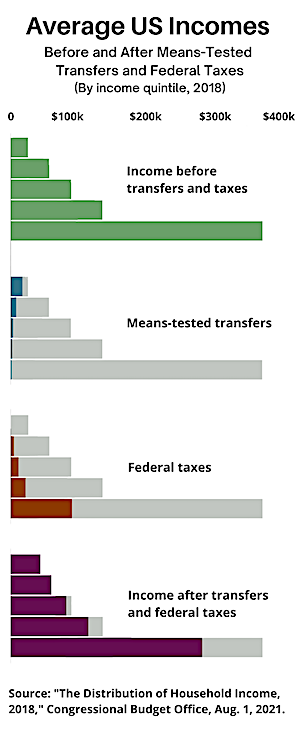

Here’s economist Larry Kotlikoff’s scary argument: Today’s low yields (and high prices) on government securities reflect investors’ flight to safety—but the flight is driven less by confidence in Uncle Sam’s financial strength than by the existential uncertainty that the government’s rising debt load creates.
Ergo, the government shouldn’t use its current low borrowing costs as an excuse or rationale to keep borrowing, Kotlikoff claims. More public debt will make investors more anxious, scare them into buying more Treasury debt, and extend a vicious cycle.
This is the paradox or irony concocted by the Boston University professor—who ran for president of the US in 2016 and likes to call Social Security a Ponzi scheme—in two June 2021 papers, “Deficit Follies” and “When Interest Rates Go Low, Should Public Debt Go High?”
“Uncertainty about the resolution of government debt policies can, itself, lower the government’s borrowing rate, making deficits look cheaper precisely when they are becoming economically more expensive,” he and his three co-authors write.
In this edition of RIJ’s Research Roundup, we summarize these and three other recent articles and working papers by US economic analysts. These include an evaluation of President’s Biden’s plan to repair America’s infrastructure; a study of American reactions to financial windfalls; and a research brief from Boston College on the extent to which Social Security penalizes motherhood.
“Deficit Follies,” by Johannes Brumm, Xiangyu Feng and Laurence J. Kotlikoff. (NBER Working Paper 28952), and “When Interest Rates Go Low, Should Public Debt Go High?” (NBER Working Paper 28951).
In these two papers, Kotlikoff and his co-authors dispute French economist Olivier J. Blanchard’s controversial suggestion that a government can borrow-and-spend without much harm if the interest rate on its debt is lower than its economy’s growth rate.
Here’s what Blanchard wrote in 2019: “If the future is like the past, this implies that debt rollovers, that is the issuance of debt without a later increase in taxes may well be feasible. Put bluntly, public debt may have no fiscal cost,” Blanchard wrote in “Public Debt and Low Interest Rates.” (NBER Working Paper 25621).
Kotlikoff et al. attack that idea from three directions. The first involves the supposed paradox of deficit spending, noted above: Deficit spending creates investor anxiety, but investors don’t shun government debt. Instead, they buy more, driving prices up and yields down. Perversely, that encourages more Treasury sales, more public debt, and more anxiety.
“Political and economic risks are causing people to be so scared that they’re bidding up safe assets,” Kotlikoff told RIJ recently. “It doesn’t follow that you should take from the young to give to the old. You should understand the risk and fix it. That would argue for progressive taxation from winners to losers. The safe rate then goes back to the rate of return on capital.”
His second point is that the government’s liability for future Social Security benefits effectively adds tens of trillions of dollars to the existing long-term federal debt.
“With Social Security, you’re taking from young people and, promising to give them benefits in future. With government bonds, you’re taking the money and promising interest in the future,” he said in our interview. “It’s just different labels for the same thing. The government is generating uncertainty over which generation is going to be on the hook to resolve these unsustainable policies.”
Kotlikoff’s third message is that deficit spending beggars future American workers. “I think we have a history of taking from the young and giving to the old, to the point where we’re endangering the economic welfare of the young. We should have been taking taxes from people, we should not have been using a deficit-expense response.
“My kids and all the other kids will have to pay. And if we don’t tax ourselves to pay for the victims, then we leave the debt to our kids and we [the older generation] will end up having to consume more. The [cost of Social Security] should have been kept within a generation [not transferred across generations].”
Instead, these researchers conclude, the US should abandon the “pay-as-you-go” financing (which the paper calls “take-go”) method that it currently uses and let each generation pay, via taxes, for its own future retirement benefits. “Relative to running the risk-sharing policy, either immediately or down the road, engaging in take-go is a government-organized Ponzi scheme—making early participants better off and inducing future cohorts to participate in what is a hard-to-discern bad deal to recoup their investment.”
“Can Biden Build Back Better? Yes, If He Abandons Fiscal ‘Pay Fors.’” Levy Institute Policy Brief No. 155, June 2021.
Fifty years ago, the economist Abba Lerner favored “functional finance” over “sound finance.” Sound finance meant aiming for a balanced budget at the federal level. Functional finance meant using deficit spending to boost the economy or correct a market failure where necessary.
Lerner’s spirit lives on in a recent Levy Institute Public Policy Brief, “Can Biden Build Back Better.” Yeva Nersisyan of Franklin and Marshall College and L. Randall Wray of Bard College claim that the policy of “budget-neutral” spending—which requires that budget cuts “pay for” or offset new federal spending—could hobble the Biden administration’s effort to spend trillions on new asphalt and digital highways.
“The ‘pay-for’ approach limits our spending on progressive policy to what we can raise through taxes, and we will only tax the amount we need to spend,” Wray and Nersisyan write, noting that such a policy “undermine[s] the goals internal to both the public investment and tax components of the administration’s plans.”
Echoing Lerner, Nersisyan and Wray recommend that the importance of a public policy goal, rather than its cost, should guide spending and taxation decisions. “If the purpose of taxing corporations and wealthy individuals is to reduce inequality, then the tax changes should be formulated to accomplish that—not to ‘raise funds’ to finance proposed spending,” they write.
“And while it is possible that general tax hikes might be needed to prevent public investment programs from fueling inflation… the kinds of taxes proposed by the administration would do little to relieve inflationary pressures should they arise,” they write. “Under current economic circumstances, however, the president’s proposed infrastructure spending should not require budgetary offsets or other measures to control inflation.”
“How Much Does Social Security Offset the Motherhood Penalty?” Center for Retirement Research at Boston College. Issue in Brief, July 2021, Number 21-11.
Social Security’s rules both favor and punish spouses—primarily women—for the time they spend out of the workforce and at home raising children. This report from the Center for Retirement Research (CRR) at Boston College tries to net out the pros and cons of that policy.
In their paper, Matthew S. Rutledge, Alice Zulkarnain, and Sara Ellen King (current and former CRR researchers) found that, on average, mothers miss a lot of Social Security benefits by staying at home when they might have been at work, contributing to the program and earning credits.
But the program helps after they retire. “Social Security is able to offset a significant amount of the penalty by the time mothers reach retirement through two separate channels: the progressive design of worker benefits and the availability of spousal benefits,” they write.
Non-working mothers tend to benefit from the tilt of Social Security benefits toward low-earners. They also benefit from the rule that provides them with at least half of their working spouses’ monthly benefit in retirement. In addition, surviving widows and widowers—whether they worked for pay or not—can receive the higher of their late spouses’ benefit or their own until they die.
The study finds that mothers earn, at the median, only 37% as much as childless women during their lifetimes. Median earnings for childless women are $3,850 per month, compared to $1,409 for women with children. But mothers receive, at the median, 60% as much in Social Security benefits as childless women.
The median Social Security benefit is $1,301 per month for childless women and $785 per month for mothers. Retired mothers with one child receive a median $974 per month from Social Security, while mothers with two children receive $847 per month.
Eighty years ago, at the birth of Social Security, men typically worked and women typically stayed home. But a lot has happened since then, like two waves of “feminism.” “In recent generations, women’s labor force participation and earnings have increased, so more women get Social Security benefits solely on their own earnings record,” the researchers wrote. But “as marriage rates have decreased and divorce rates have increased, fewer women meet the 10-year marriage threshold. [So] the share of women receiving a spousal benefit has plummeted from 35% in 1960 to 18% in 2019.”
“How Americans Respond to Idiosyncratic and Exogenous Changes in Household Wealth and Unearned Income” (NBER Working Paper No. 29000, July 2021)
If you won a Lotto jackpot or received some other financial windfall near your retirement age, would you work fewer hours? Would you retire? Would you move to a nicer house in a better neighborhood? Alternately, how would you respond to a hike in your marginal income tax rate?
Hoping to anticipate the domino effects of the introduction of a Universal Basic Income (UBI) in the US and a marginal tax hike on the wealthy to pay for it, four economists set out to learn if those policies would have the intended effect, or if they might backfire.
Combining “administrative data on US lottery winners with an event-study design that exploits variation in the timing of lottery wins,” University of Chicago researchers Mikhail Golosov, Michael Graber, Magne Mogstad and David Novgorodsky found that wealthier and poorer people respond differently to windfalls.
On average, “For an extra $100 in wealth, [US] households reduce their annual earnings by approximately $2.30,” the authors write. But averages hide the disparity between rich and poor. “Households in the bottom quartile of the pre-win income distribution reduce their annual household labor earnings by $1.30 per $100 dollars of additional wealth, whereas winners in the top quartile decrease their annual household labor earnings by $3.10 dollars per $100 of additional wealth,” the paper said.
In other words, poorer people tend to keep their day jobs and buy more stuff when they hit the jackpot. Richer people, who presumably already own lots of stuff, tend to “prioritize reducing labor over increasing consumption.”
The researchers also sought to learn if raising a poor family’s disposable income with a UBI would inspire it to move to a better neighborhood where the housing stock, the schools, and the chances for upward social mobility might be greater.
Again, poor and wealthy families appeared to respond differently. Not surprisingly, “Lower-income households are much more likely to move: the increase in the probability of moving for winners in the lowest quartile is around five times as large as that of the winners in the highest quartile for an extra 100,000 dollars in wealth.”
But the effect is diluted by other factors. “Pure unconditional cash transfers do not lead households to systematically move to locations of higher quality, consistent with the [well-documented] importance of non-financial barriers to moving to better neighborhoods.”
© 2021 RIJ Publishing LLC. All rights reserved.